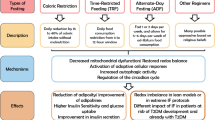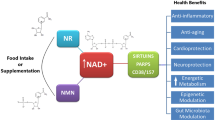ABSTRACT
Purpose
To study the effects of N-acetylcysteine (NAC, C5H9NO3S) on diet-induced obesity and obesity-related metabolic disorders.
Methods
Six-week-old male C57BL/6 mice fed a chow or high-fat diet (HFD) were treated with NAC (2 g/L) in drinking water for 11 weeks. Its influences on body weight and food intake were manually measured, and influence on body composition were analyzed by magnetic residence imaging. Glucose meter and ELISA were used to determine serum glucose and insulin levels, as well as lipid content in the liver. The effects of NAC treatment on mRNA levels of genes involved in inflammation, thermogenesis, and lipid metabolism in various tissues were determined by real time PCR.
Results
NAC supplementation inhibited the increase of fat mass and the development of obesity when mice were fed an HFD. NAC treatment significantly lowered HFD-induced macrophage infiltration, and enhanced adiponectin gene expression, resulting in reduced hyperglycemia and hyperinsulinemia, and improvement of insulin resistance. NAC oral administration suppressed hepatic lipid accumulation, as evidenced by lower levels of triglyceride and cholesterol in the liver. The beneficial effects are associated with a decrease of hepatic Pparγ and its target gene expression, and an increase in the expression of genes responsible for lipid oxidation and activation of farnesoid X receptor. Furthermore, NAC treatment also stimulates expression of thermogenic genes.
Conclusion
These results provide direct proof of the protective potential of NAC against HFD-induced obesity and obesity-associated metabolic disorders.







Similar content being viewed by others
Abbreviations
- ANOVA:
-
Analysis of variance
- BAT:
-
Brown adipose tissue
- CD68:
-
Cluster of differentiation 68
- Cox2:
-
Cyclooxygenase 2
- Cpt1:
-
Carnitine palmitoyltransferase 1
- Cyp7a1:
-
Cholesterol 7 alpha-hydroxylase
- Dio2:
-
Type II iodothyronine deiodinase
- FXR:
-
Farnesoid X receptor
- Gapdh:
-
Glyceraldehyde-3-Phosphate Dehydrogenase
- GTT:
-
Glucose tolerance test
- H&E:
-
Haematoxylin and eosin stain
- HDL:
-
High-density lipoprotein
- HFD:
-
High fat diet
- Inos:
-
Inducible nitric oxide synthase
- ITT:
-
Insulin tolerance test
- LDL:
-
Low-density lipoprotein
- LPS:
-
Lipopolysaccharide
- Mcp1:
-
Monocyte chemotactic protein 1
- Mgat1:
-
Monoacylglycerol O-acyltransferase 1
- NADPH:
-
Nicotinamide adenine dinucleotide phosphate
- Pgc1α:
-
Peroxisome proliferator-activated receptor gamma coactivator 1-alpha
- Ppar:
-
Peroxisome proliferator-activated receptor
- RT-PCR:
-
Real time PCR
- SD:
-
Standard deviation
- Shp:
-
Small heterodimer partner
- Tnfα:
-
Tumor necrosis factor alpha
- Ucp:
-
Uncoupling Protein
- WAT:
-
White adipose tissue
REFERENCES
Millea PJ. N-acetylcysteine: multiple clinical applications. Am Fam Physician. 2009;80(3):265–9.
Kelly GS. Clinical applications of N-acetylcysteine. Altern Med Rev. 1998;3(2):114–27.
Atkuri KR, Mantovani JJ, Herzenberg LA, Herzenberg LA. N-Acetylcysteine--a safe antidote for cysteine/glutathione deficiency. Curr Opin Pharmacol. 2007;7(4):355–9.
Tirouvanziam R, Conrad CK, Bottiglieri T, Herzenberg LA, Moss RB, Herzenberg LA. High-dose oral N-acetylcysteine, a glutathione prodrug, modulates inflammation in cystic fibrosis. Proc Natl Acad Sci U S A. 2006;103(12):4628–33.
Tanaka Y, Gleason CE, Tran PO, Harmon JS, Robertson RP. Prevention of glucose toxicity in HIT-T15 cells and Zucker diabetic fatty rats by antioxidants. Proc Natl Acad Sci U S A. 1999;96(19):10857–62.
McKinnon CM, Docherty K. Pancreatic duodenal homeobox-1, PDX-1, a major regulator of beta cell identity and function. Diabetologia. 2001;44(10):1203–14.
Song D, Hutchings S, Pang CC. Chronic N-acetylcysteine prevents fructose-induced insulin resistance and hypertension in rats. Eur J Pharmacol. 2005;508(1–3):205–10.
Diniz YS, Rocha KK, Souza GA, Galhardi CM, Ebaid GM, Rodrigues HG. Effects of N-acetylcysteine on sucrose-rich diet-induced hyperglycaemia, dyslipidemia and oxidative stress in rats. Eur J Pharmacol. 2006;543(1–3):151–7.
Blouet C, Mariotti F, Azzout-Marniche D, Mathe V, Mikogami T, Tome D, et al. Dietary cysteine alleviates sucrose-induced oxidative stress and insulin resistance. Free Radic Biol Med. 2007;42(7):1089–97.
Ho E, Chen G, Bray TM. Supplementation of N-acetylcysteine inhibits NFkappaB activation and protects against alloxan-induced diabetes in CD-1 mice. FASEB J. 1999;13(13):1845–54.
Kaneto H, Kajimoto Y, Miyagawa J, Matsuoka T, Fujitani Y, Umayahara Y, et al. Beneficial effects of antioxidants in diabetes: possible protection of pancreatic beta-cells against glucose toxicity. Diabetes. 1999;48(12):2398–406.
Lin CC, Yin MC, Hsu CC, Lin MP. Effect of five cysteine-containing compounds on three lipogenic enzymes in Balb/cA mice consuming a high saturated fat diet. Lipids. 2004;39(9):843–8.
Yang R, Le G, Li A, Zheng J, Shi Y. Effect of antioxidant capacity on blood lipid metabolism and lipoprotein lipase activity of rats fed a high-fat diet. Nutrition. 2006;22(11–12):1185–91.
Korou LM, Agrogiannis G, Pantopoulou A, Vlachos IS, Iliopoulos D, Karatzas T, et al. Comparative antilipidemic effect of N-acetylcysteine and sesame oil administration in diet-induced hypercholesterolemic mice. Lipids Health Dis. 2010;9:23.
Novelli EL, Santos PP, Assalin HB, Souza G, Rocha K, Ebaid GX, et al. N-acetylcysteine in high-sucrose diet-induced obesity: energy expenditure and metabolic shifting for cardiac health. Pharm Res. 2009;59(1):74–9.
Fernandez-Sanchez A, Madrigal-Santillan E, Bautista M, Esquivel-Soto J, Morales-Gonzalez A, Esquivel-Chirino C, et al. Inflammation, oxidative stress, and obesity. Int J Mol Sci. 2011;12(5):3117–32.
Ma Y, Huang Y, Yan L, Gao M, Liu D. Synthetic FXR agonist GW4064 prevents diet-induced hepatic steatosis and insulin resistance. Pharm Res. 2013;30(5):1447–57.
Ma Y, Gao M, Liu D. Chlorogenic acid improves high Fat diet-induced hepatic steatosis and insulin resistance in mice. Pharm Res. 2015;32(4):1200–9.
Weisberg SP, McCann D, Desai M, Rosenbaum M, Leibel RL, Ferrante Jr AW. Obesity is associated with macrophage accumulation in adipose tissue. J Clin Invest. 2003;112(12):1796–808.
Gavrilova O, Haluzik M, Matsusue K, Cutson JJ, Johnson L, Dietz KR, et al. Liver peroxisome proliferator-activated receptor gamma contributes to hepatic steatosis, triglyceride clearance, and regulation of body fat mass. J Biol Chem. 2003;278(36):34268–76.
Furukawa S, Fujita T, Shimabukuro M, Iwaki M, Yamada Y, Nakajima Y, et al. Increased oxidative stress in obesity and its impact on metabolic syndrome. J Clin Invest. 2004;114(12):1752–61.
Oliver E, McGillicuddy F, Phillips C, Toomey S, Roche HM. The role of inflammation and macrophage accumulation in the development of obesity-induced type 2 diabetes mellitus and the possible therapeutic effects of long-chain n-3 PUFA. Proc Nutr Soc. 2010;69(2):232–43.
Wellen KE, Hotamisligil GS. Obesity-induced inflammatory changes in adipose tissue. J Clin Invest. 2003;112(12):1785–8.
Bu L, Gao M, Qu S, Liu D. Intraperitoneal injection of clodronate liposomes eliminates visceral adipose macrophages and blocks high-fat diet-induced weight gain and development of insulin resistance. AAPS J. 2013;15(4):1001–11.
Cui R, Gao M, Qu S, Liu D. Overexpression of superoxide dismutase 3 gene blocks high-fat diet-induced obesity, fatty liver and insulin resistance. Gene Ther. 2014;21(9):840–8.
Calzadilla P, Sapochnik D, Cosentino S, Diz V, Dicelio L, Calvo JC, et al. N-acetylcysteine reduces markers of differentiation in 3 T3-L1 adipocytes. Int J Mol Sci. 2011;12(10):6936–51.
Pajonk F, Riess K, Sommer A, McBride WH. N-acetyl-L-cysteine inhibits 26S proteasome function: implications for effects on NF-kappaB activation. Free Radic Biol Med. 2002;32(6):536–43.
Oka S, Kamata H, Kamata K, Yagisawa H, Hirata H. N-acetylcysteine suppresses TNF-induced NF-kappaB activation through inhibition of IkappaB kinases. FEBS Lett. 2000;472(2–3):196–202.
Glass CK, Olefsky JM. Inflammation and lipid signaling in the etiology of insulin resistance. Cell Metab. 2012;15(5):635–45.
Lee BC, Lee J. Cellular and molecular players in adipose tissue inflammation in the development of obesity-induced insulin resistance. Biochim Biophys Acta. 2014;1842(3):446–62.
Scherer PE, Williams S, Fogliano M, Baldini G, Lodish HF. A novel serum protein similar to C1q, produced exclusively in adipocytes. J Biol Chem. 1995;270(45):26746–9.
Diez JJ, Iglesias P. The role of the novel adipocyte-derived hormone adiponectin in human disease. Eur J Endocrinol. 2003;148(3):293–300.
Kubota N, Terauchi Y, Yamauchi T, Kubota T, Moroi M, Matsui J, et al. Disruption of adiponectin causes insulin resistance and neointimal formation. J Biol Chem. 2002;277(29):25863–6.
Maeda N, Shimomura I, Kishida K, Nishizawa H, Matsuda M, Nagaretani H, et al. Diet-induced insulin resistance in mice lacking adiponectin/ACRP30. Nat Med. 2002;8(7):731–7.
Ma Y, Liu D. Hydrodynamic delivery of adiponectin and adiponectin receptor 2 gene blocks high-fat diet-induced obesity and insulin resistance. Gene Ther. 2013;20(8):846–52.
Sekiya M, Hiraishi A, Touyama M, Sakamoto K. Oxidative stress induced lipid accumulation via SREBP1c activation in HepG2 cells. Biochem Biophys Res Commun. 2008;375(4):602–7.
Cannon B, Nedergaard J. Brown adipose tissue: function and physiological significance. Physiol Rev. 2004;84(1):277–359.
Bartelt A, Bruns OT, Reimer R, Hohenberg H, Ittrich H, Peldschus K, et al. Brown adipose tissue activity controls triglyceride clearance. Nat Med. 2011;17(2):200–5.
Acknowledgments and Disclosures
We thank Mrs. Francisca Burnley for proofreading and English editing. This work was supported in part by the National Institute of Health [RO1 HL098295].
Author information
Authors and Affiliations
Corresponding author
Electronic supplementary material
Below is the link to the electronic supplementary material.
ESM 1
(DOCX 23 kb)
Fig. S1
NAC treatment represses LPS-induced expression of inflammation response genes in macrophages. RAW264.7 cells were treated with LPS (100 ng/ml) in the presence of various doses of NAC for 24 h. Cells were harvested and total RNA was extracted for RT-PCR analysis. Relative mRNA levels of (a) Inos; (b) Cox2; (c) Mcp1; and (d) Tnfα. **P < 0.01 compared to LPS treatment without NAC (n = 3). (GIF 50 kb)
Rights and permissions
About this article
Cite this article
Ma, Y., Gao, M. & Liu, D. N-acetylcysteine Protects Mice from High Fat Diet-induced Metabolic Disorders. Pharm Res 33, 2033–2042 (2016). https://doi.org/10.1007/s11095-016-1941-1
Received:
Accepted:
Published:
Issue Date:
DOI: https://doi.org/10.1007/s11095-016-1941-1




